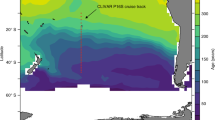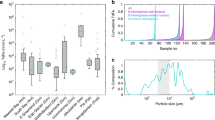Abstract
MARTIN et al. have proposed an ingenious means by which the rise in atmospheric CO2 content generated by the burning of fossil fuels and deforestation might be partially compensated1. The idea is that plant production in the nutrient-rich surface waters of the Antarctic could be stimulated by the addition of dissolved iron, thereby reducing the CO2 partial pressure in these waters and allowing CO2 to flow from the atmosphere into the Antarctic Ocean. We have used a box model calibrated with transient tracer data to examine the dynamical aspects of this proposal, and conclude that after 100 years of totally successful fertilization the CO2 content of the atmosphere would be lowered by only 10±5% below what it would have been in the absence of fertilization. So if after 100 years the CO2 content of the atmosphere were 500 fjiatm without fertilization, it would be between 425 and 475 µ atm with full fertilization. In other words, if our model calibration is correct, even if iron fertilization worked perfectly it would not significantly reduce the atmospheric CO2 content.
This is a preview of subscription content, access via your institution
Access options
Subscribe to this journal
Receive 51 print issues and online access
$199.00 per year
only $3.90 per issue
Buy this article
- Purchase on Springer Link
- Instant access to full article PDF
Prices may be subject to local taxes which are calculated during checkout
Similar content being viewed by others
References
Baum, R. Chem. Engng. News 68, 21–24 (1990).
Martin, J. H. & Fitzwater, S. E. Nature 331, 341–343 (1988).
Martin, J. H. & Gordon, R. M. Deep Sea Res. 35, 177–196 (1988).
Martin, J. H., Gordon, R. M., Fitzwater, S. & Broenkow, W. W. Deep Sea Res. 38, 649–680 (1989).
Martin, J. H., Gordon, R. M. & Fitzwater, S. Nature 345, 156–158 (1990).
Martin, J. H. Palaeoceanography 5, 1–13 (1989).
Deacon, G. E. R. Discovery Rep. 15, 125–152 (1937).
Ostlund, H. G. & Stuiver, M. Radiocarbon 22, 25–53 (1980).
Stuiver, M. & Ostlund, H. G. Radiocarbon 22, 1–24 (1980).
Stuiver, M. & Ostlund, H. G. Radiocarbon 25, 1–29 (1983).
Broecker, W. S., Peng, T-H., Ostlund, G. & Stuiver, M. J. geophys. Res. 90, 6953–6970 (1985).
Oeschger, H., Siegenthaler, U., Schotterer, U. & Gugelman, A. Tellus 27, 168–192 (1975).
Foster, T. D. & Weiss, R. F. Antarct. J. U. S. 74, 76 (1988).
Stouffer, R. F., Manabe, S. & Bryan, K. Nature 342, 660–662 (1989).
Author information
Authors and Affiliations
Rights and permissions
About this article
Cite this article
Peng, TH., Broecker, W. Dynamical limitations on the Antarctic iron fertilization strategy. Nature 349, 227–229 (1991). https://doi.org/10.1038/349227a0
Received:
Accepted:
Issue Date:
DOI: https://doi.org/10.1038/349227a0
This article is cited by
-
Can Advances in Science and Technology Prevent Global Warming?
Mitigation and Adaptation Strategies for Global Change (2006)
-
Model simulations of carbon sequestration in the northwest Pacific by patch fertilization
Journal of Oceanography (2006)
-
Effect of iron supply on Southern Ocean CO2 uptake and implications for glacial atmospheric CO2
Nature (2000)
-
Volcanic iron, CO2, ocean productivity and climate
Nature (1997)
-
Large decrease in ocean-surface CO2 fugacity in response to in situ iron fertilization
Nature (1996)
Comments
By submitting a comment you agree to abide by our Terms and Community Guidelines. If you find something abusive or that does not comply with our terms or guidelines please flag it as inappropriate.



